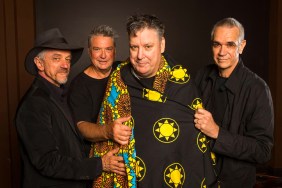The relationship between the music industry and the music press has long been a murky one. It’s often hard to distinguish where criticism ends and promotion begins, and when artists start receiving critical attention the chicken-or-the-egg question usually arises. How much influence does exposure and hype have on the popularity and perceived quality of music?
The pitfalls of this relationship were highlighted in the early 2000s when NME, ever the self-proclaimed tastemakers, identified the formation of a movement they dubbed the “new garage rock revolution”. The global music press followed suit, ordaining bands like The Strokes, The White Stripes and The Vines as “the saviours of rock ‘n’ roll”. This was, to be tactful, a grossly miscalculated exaggeration.
By 2006, it was abundantly clear that there was no radical shift in the musical landscape. Sure, a couple of genuinely classic albums and a handful of exciting artists can be regarded as products of that climate, but there was never a watershed moment signalling the industry was somehow drastically altered. Whether cynically or out of hubris, it appeared that the press had attempted to use their own influence to effect change, as much for their own benefit as for anyone else.
But sometimes, in a rare convergence of promotion, production and appreciation, music critics can legitimately have an impact on the sound of a generation. This is what happened in 1972 with the release of the seminal garage rock (yes, that phrase again) compilation Nuggets: Original Artyfacts from the First Psychedelic Era. Lauded as one of the most influential collections of all time, it’s now being released in a remastered 40th anniversary edition, alongside two companion records – Down Under Nuggets: Original Australian Artyfacts 1965-1967 and Nuggets: Antipodean Interpolations of the First Psychedelic Era.
Nuggets was largely the work of one man, Lenny Kaye, a future punk luminary and guitarist for Patti Smith. At the time an emerging rock critic, Kaye had observed a definitive sound developing over the previous decade. Elements of garage rock – fuzzbox guitar, detail buried in reverb, psychedelic rotary organs, and simplistic schoolyard lyrics couched in raucous, often unmelodic vocals – had been making appearances in the American charts since The Kingsmen found success with Louie Louie in 1963. The big problem was pinning these elements down; rarely were they in the same song, in the same place at the same time.
With the help of Jac Holzman, owner of Elektra Records, Kaye pulled together 27 tracks of uncomplicated, lo-fi and undoubtedly infectious guitar music. Despite the presence of a few tracks that had made some impact on the charts, this wasn’t a bog-standard hit parade thrown together to make a quick buck. The meticulous curation and dedication to authenticity was evident; Nuggets was a genuine attempt to archive and preserve a movement which may otherwise have slipped under the radar. Not only did the record identify common themes in a previously disparate group of songs, but the extensive liner notes (written by Kaye himself and updated and revised in this new edition) gave legitimacy to the intentionally rough-and-ready DIY aesthetic many of the tracks displayed. Most importantly, his description of the sound as “punk rock” is believed to be the term’s first documented use.
Much of the record’s appeal comes from this homespun, devil-may-care ethos, but the compilation wisely eased the early-’70s listener in before the more ambitious rawness of later tracks. Opener I Had Too Much to Dream by the Electric Prunes may be rowdy, but it’s a high-energy tune lathered in reverb, reminiscent of popular acts like The Doors and Jefferson Airplane (who had co-opted these sounds as their own). Night-Time by The Strangeloves adopts a familiar and danceable backbeat while essentially waxing lyrical about their comparative superiority to, well, everybody, and Lies by The Knickerbockers might be an early Beatles track but for the lack of vocal polish.
Then comes Oh Yeah, a highlight from The Shadows of Knight. With dead-simple, ineloquent lyrics, the vocals are laconic, and the guitar solo is far from proficient. But, like all great punk records, the attraction lies in the delivery and attitude, which is truly genuine and electrifying. These were a bunch of kids with no greater ideal than churning out lacklustre songs about their uninspiring lives. Considering the context, it’s heady stuff.
Barry & The Remains’ Don’t Look Back is more polished, relatively speaking, but again it isn’t the musical quality that catches the ear. Barry’s voice yelps and breaks with each doleful phrase, and his bandmates shout in fervent response. You’re Gonna Miss Me by The 13th Floor Elevators is even more out of control. The production is sludgy, devolving from muttered, cautionary verses (“You’re gonna wake up one morning / You’re gonna find that I’m gone“) to threatening howls of “You’re gonna miss me!” in the chorus, climaxing with a trashy, squawking harmonica solo.
Nuggets defined American garage rock as an authentic music trend and mindset, and undoubtedly inspired the rise of punk in the ’70s. Australia’s own influence on punk is well-documented, but Down Under Nuggets attempts to fill some gaps in popular history. Perhaps by necessity, these tracks have a less refined (dare I say “weirder”?) vibe than Kaye’s compilation. This is a new collection, and although some familiar tracks make appearances – including those from The Masters Apprentices, The Loved Ones and The Easybeats – the majority are rough diamonds. Unlike the US-based set, catchy organ riffs and pleasing three-part harmonies are rare, the tracks more often pointing to Radio Birdman than Russell Morris.
The Atlantics had previously found fame and respect as a surf rock band but are here represented in their post-Bombora days. Come On rejects their trademark staccato guitar, embracing the garage rock sound, perhaps inspired by their American contemporaries. Bobby & Laurie genuinely come across as a bunch of blokes who stumbled back from the pub, hit record and accidentally struck gold on their first take of No Next Time. The Bee Gees use their vocal talents to mimic tremelo effects traditionally produced by guitar on Like Nobody Else. The Throb are truly indulgent with a rudimentary, thrashy wall-of-sound effect on Black, a screeching harmonica piercing the murk. Also included is a rare extended version of iconic track The Hot Generation, something sure to get the collectors frothing.
One thing’s for certain – no-one compiled here was making concessions to appeal to a larger audience. The Aussies weren’t afraid to get a little bit freaky, and it’s great fun discovering just how good some of this music is.
Less essential, however, is Nuggets: Antipodean Interpolations, a collection of contemporary Australian artists covering tracks from the original Nuggets. Strangely, it sounds like the brief for this record was to stay as close to the classic sounds of the original era as possible, and most of these tracks exploit trademark garage rock sounds and simply turn everything up to 11. It’s certainly a different approach, and a curiosity if you’re a fan of the bands involved or the sound in general, but being released in such close proximity to the original Nuggets casts this record in a particularly unfavourable light. It feels redundant and in no way noteworthy, though thankfully there are a few pleasing exceptions.
Moulty is a kooky yarn about a one-handed drummer, told in spoken word, and Davey Lane’s Aussie drawl immediately catches your ear, also making subtle use of some modern production techniques. It’s a savvy move, capturing the essence of the song without slavishly aping it. Eagle and The Worm show the first sliver of individual personality on An Invitation to Cry. The original track’s vocals suggest a romantic melancholy, but here the tune is more plaintive and petulant.
Perhaps the furthest departure from the source material, and certainly the most modern-sounding, is Baptism of Uzi’s Baby Please Don’t Go. Purely instrumental, there’s no hint of familiarity in the extended intro until the instantly recognisable vocal line is subtly introduced via organ, and the famous guitar riff gets hacked up and reworked. There’s more punk swagger here than anything else on the album and it’s definitely welcome amidst the sea of spring reverb, slap delay and distortion substituting for attitude on most of the other songs. Elsewhere there is little other than tempo and fidelity differentiating the new renditions from their predecessors. All involved sound like they’re having fun, and the female vocals on Farmer John and Dirty Water are refreshing, but there’s little in terms of imaginative interpretation to be found here.
All three of these records have their merits, but only the original Nuggets can indisputably claim to be groundbreaking and influential. Down Under Nuggets is a strange and fascinating exploration of the Australian music underbelly before the punk and pub rock boom. Nuggets: Antipodean Interpolations, for the most part, resigns itself to educating those of us unfamiliar with the good old days. Those responsible would probably agree, but if these compilations teach us anything, it’s that you can never predict the direction good music will take us, or the influence it will have in the future.
Nuggets Collection
Nuggets: Original Artyfacts from the First Psychedelic Era
Down Under Nuggets: Original Australian Artyfacts 1965-1967
Nuggets: Antipodean Interpolations of the First Psychedelic Era












